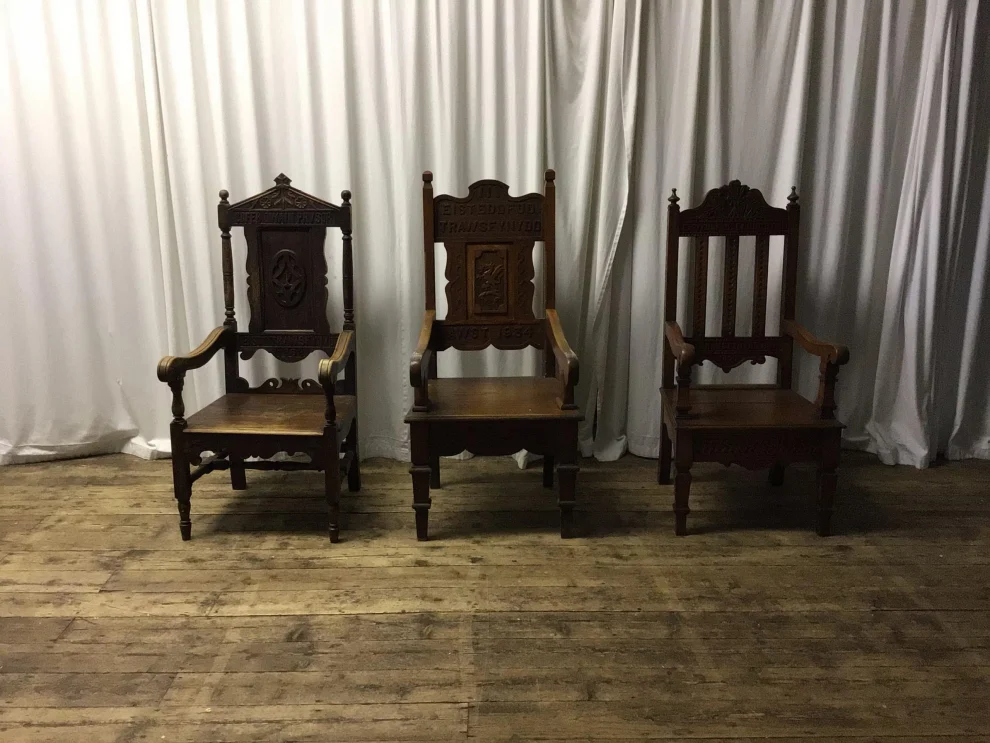BARDIC chairs are a very interesting and unique tradition to Wales.
Chairs are awarded to a bard who succeeds in writing a set of poems that adhere to strict measures known as ‘Cynghaneddion’. The bard must win a poetry writing competition in an Eisteddfod to win a chair. Although some Eisteddfodau such as Yr Eisteddfod Genedlaethol, Eisteddfod yr Urdd, as well as some local Eisteddfodau still give chairs as the main prize in competitions, the norm now is to give a miniature version of a chair, because the cost of making a chair has increased substantially, and the labour that goes in to making and carving an eisteddfod chair is immense.
There are a lot of notable chairs in Wales, but none as notable as ‘Y Gadair Ddu’, which Ellis Humphries Evans, known better by his bardic name Hedd Wyn, won the chair in the Eisteddfod Genedlaethol in 1917, but he unfortunately lost his life at passchendaele before he knew that he was victorious at the Eisteddfod. His home at Trawsfynydd is now a museum called ‘Yr Ysgwrn’ (the name of the farm) – the name ‘Yr Ysgwrn’ has had a lot of attention over the past few years, and has been in the limelight recently, because the poet’s nephew, and former custodian / resident of Yr Ysgwrn, Mr Gerald Williams, has sadly passed away at the age of 92.

Hedd Wyn’s story is deeply tragic and heartbreaking, and has become symbolic of the mourning and loss experienced by the families after WW1 in Wales and across the world. The name ‘Y Gadair Ddu’ also has become synonymous with grief and tragedy. But, it has come to light that Y Gadair Ddu isn’t the only Eisteddfod chair in Trawsfynydd that is connected to grief and tragedy, as the people of the village discovered in the past few weeks…
The Chair
Recently, Mike Williams from Penrhosgarnedd, Ynys Mon, contacted a member of Trawsfynydd Community Council to mention that he had a bardic Chair from 1882 at his home, which he wanted to give back to the people of Trawsfynydd on a permanent loan.
The Chair is beautifully designed, with symbols of flowers and oak leaves, wavy patterns across the back and on the armrests, and in the middle at the bottom, the letters ‘EISTd TRAWSFYNYDD, 1882 ’ are carved carefully into the wood on the chair. Although these features are certainly eye-catching, the most striking feature on the chair are the words ‘COFEB OWAIN PRYSOR’ (Memorial to Owain Prysor) written across the middle of the top. The name has raised eyebrows in the village with people asking who Owain Prysor was, what had happened to this person, and why the chair was dedicated to him.
Who Was Owain Prysor?
After some research into old newspapers from the era by local historian Keith O’Brien, he came across two articles that shed light on what happened to Owain Prysor, and how the chair became the prize of the 1882 Llungwyn Eisteddfod. Owain Jones, or better known by the community as Owain Prysor, was born 1806/7 in Penlan, in the village of Trawsfynydd, as the son of a cobbler / unlicensed surgeon. Like his father, Owain became a cobbler in Trawsfynydd, and also, was renowned as an unlicensed surgeon. The article mentions that he had treated many in the community over the years, and everybody had been in contact for his service at some point in their lives. As well as being a cobbler and surgeon, he was also an active member with the Wesleyan Chapel in the village, and was well known as a bard himself, he was described as ‘a master of the strict measures’ even though a lot of his work ‘wasn’t published’.
The Accident
A clip in a newspaper ‘Llais y wlad’ on the 22nd of April, 1881, mentions on the 8th of April, Owain was travelling with a friend on the train between ‘Trawsfynydd and Blaenau Ffestiniog’(believed to be the narrow gauge railway between Llan Ffestiniog and Blaenau Ffestiniog that existed before the Bala to Blaenau Ffestiniog Railway was opened in 1883) when disaster struck. As the train travelled between Blaenau Ffestiniog and Trawsfynydd, it is believed that Owain was standing on the side of the train when it was moving when it came in contact with another vehicle carrying iron rails. One of the rails came loose and struck Owain in the thigh and haunch. After fighting on for 2 days after the accident he sadly succumbed to his wounds and died at the age of 75 on April 10th, 1881. A service was held in the Wesleyan chapel in the village, and he was interred in the Church graveyard.
Commemarative Chair
The chair was commissioned by family and friends of Owain for the yearly Llungwyn eisteddfod held in Trawsfynydd in 1882. The chair was a prize in the Eisteddfod for the bard that could write the most fitting Marwnad (elegy in the form of poetry) to the memory of Owain Prysor. Many bards competed in the Llungwyn Eisteddfod for the chair, but it was Gwilym Padarn who was victorious with his tribute to Owain Prysor.
The journey that the Chair took between 1882 and the present date is a bit vague, with the current owner stating that he believed that his Grandmother received the chair at some point in the early part of the 20th century from a family member. After that it was passed down to his parents, then on to him.
The chair has now taken its place in the village hall in Trawsfynydd for everyone to marvel at. The community is very grateful to Mr Mike Williams for lending them the chair permanently. By returning the chair to the community, Mr Williams has helped Trawsfynydd shed a light on its past, and the skills that the village has nurtured over the centuries.It has also reminded everyone in the community about the life and tragic ending of Owain Prysor, whose passing was a heartbreaking event in the village’s history, but his memory and spirit will now live on through the history of the chair.


















Add Comment